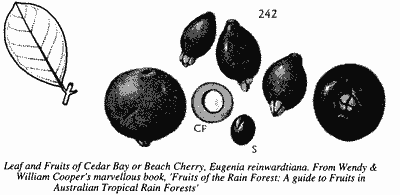
THE CEDAR BAY CHERRY - A Great Bush Tucker Prospect
SCIENTIFIC NAME: Eugenia reinwardtiana
FAMILY: Myrtaceae
Many older members of SGAP would remember a time when all the Lillypillies were known as Eugenia. During the 1980s, this was revised and the whole group were split up, into Syzygium and Acmena. Only one solitary plant remained in Eugenia and that was the Cedar Bay Cherry.
Of course there are still about 1000 Eugenias in other parts of the world; most familiar to many home gardeners is the Brazilian Cherry (Eugenia uniflora), or possibly even the Grumichama (Eugenia brasiliensis). Our native Eugenia has also undergone a name change. Formerly Eugenia carissioides, it is now known as E. reinwardtiana.
Enough of the technical aspects now. The name 'Cedar Bay Cherry' obviously derives from the fact that it is a common shrub at Cedar Bay in the Daintree area, but it is by no means confined to there. Indeed, they may be found anywhere from Bundaberg to the Torres Strait and into Papua New Guinea and many other countries as well.
It grows in many forms and many habitats, although usually as a low bush or small tree. On off-shore islands, rocky headlands and protected beach fronts, it is possible to find the cherry growing. It also occurs along dry creek beds in association with deciduous vine thicket or dry rainforest species.

The leaves are opposite and when crushed, exude that apple sort of smell so common with members of the family Myrtaceae. The flowers are white and delicate, with a small tuft of fine stamens growing from the centre. These are produced sporadically over the plant and are followed by a sweet edible fruit.
The size, taste, colour and texture of the fruit vary to such a degree that many people are convinced that more than one species must be involved. Those from the northern rainforest and Cape York Peninsula areas have large, fleshy leaves and a bright red globular fruit, varying in size from a cherry pip to the size of a cumquat.
Local vine-thicket varieties from the Townsville-Bowen area have very thin, small leaves, while the fruit is bright orange, often elongated and tear-shaped. They have more than a passing resemblance to some very nasty chillies I have eaten in the past.
The Cedar Bay Cherry is now attracting a large amount of interest from general home gardeners as well as diehard native plant enthusiasts. Many believe that this plant has great potential for the exotic fruit and bush tucker markets because of the eating quality of the fruit.
Personally, I have about fifteen adult plants in cultivation from which I regularly gather fruit. The largest and most spectacular fruiter was one I actually purchased from the fruit tree section of the local nursery. Realising the importance of experimenting with as many different varieties as possible, I have plants in from around north Queensland and have just planted over 100 seeds of the unusual Townsville variety.
I am looking for all the variations of fruit size, seed size and flavour. Perhaps there is the possibility of grafting the superior fruiting variety from the wet tropics to the hardier rootstock of our local variety. I had considered grafting Cedar Bay Cherry onto Brazilian Cherry, but who could be so mean to a Cedar Bay Cherry?
This plant is certain to become one of the most popular native shrubs and bush tucker plants in cultivation in the Townsville area and it should be heavily promoted.
DATE: February 2000
* * * * * * * * * * * * *
